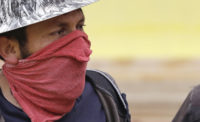Coronavirus and Construction
Sorting the Differences in Pandemic Face Coverings

Some of the face coverings subject to new test method devised by Duke University research team: Photo: Emma Fischer/Duke University
R
esearch teams and government health officials are expanding the understanding of face coverings and the coronavirus by warning that two popular types of coverings may fail to inhibit virus spread as much as other choices and that one type may actually worsen it.
Researchers at Duke University found that a style of face covering popular among construction workers—thin fabric tubes with elastic ends called buffs, gaiters or fleeces—could send droplets into the air and may be worse than no covering at all. And the U.S. Centers for Disease Control and Prevention has recently pointed out in new guidelines that valved N95 face masks—the conical fabric masks that meet Occupational Safety and Health Administration and ANSI standards, and qualify as personal protective equipment for many dusty environments, are less effective than the unvalved variety.
“We expect there are variations of performance” and “there are just too many different mask types to test them all.”
– Martin C. Fischer, Duke University
The newest research arrives on an already cluttered landscape of virus-related protective practices for workers. Some of the different approaches involve workers and employers choosing between effective virus protection and comfort, convenience and productivity, and increased costs. Employers of all types have long been responsible for protecting workers from familiar respiratory hazards that include toxic gases, carcinogenic dust particles or oxygen-low air. The pandemic has put a new twist on that responsibility.
The Duke study’s most striking finding is that the popular thin fabric buffs could actually encourage virus spread. Valued for versatility and convenience, the buffs allow workers to easily drop the covering from their noses and mouths to cool faces, untrap carbon dioxide and allow eye protection to defog. Earlier this summer, such face coverings were distributed free to union bricklayers in a Northwestern local. The local’s business manager spoke of his members’ need for heat relief while doing heavy work.
In the Duke study, researchers used a low-cost system to measure the potential spread of droplets larger than 0.5 microns. Volunteers spoke a few words into a dark chamber and, using a laser and camera, researchers visually recorded droplet spread. To measure differences between face coverings, scientists counted exhaled droplets traveling from the mask, measured in microns. The virus, many times smaller, hitches a ride on the droplets.
This method was used to study 14 common face-covering designs with a single speaker. Researchers also tested several types of masks with four different speakers. The mask types ranged from a typical, three-layer surgical mask to valved and unvalved N95 masks, to layered combinations of cotton and polypropylene and masks with pleats. Unvalved, fitted N95 masks were determined to be the best at reducing virus spread.
Lightest Weight Fabric in Fleece
To test the buffs or fleeces, the authors selected one made of a thin polyester and spandex, a product that provides a breathable fabric ideal for keeping cool. But the thin fabric, the Duke team found, transmitted numerous droplets and filtered them into smaller pieces. “That’s primarily why they got through” the protection, Martin C. Fischer, a research professor in the department of chemistry and one of the authors, said by email. By transmitting smaller aerosol micro-drops, the fleece also may send the virus farther than heavier, fasting-falling droplets would travel without a mask. “Considering that smaller particles are airborne longer than large droplets … the use of such a mask might be counterproductive,” the authors wrote in the journal Science Advances.
Different types of fleece masks, with different test subjects, could produce different results. “We expect there are variations of performance” and “there are just too many different mask types to test them all,” Fischer says.
So far the battle against jobsite virus spread has been waged through a changing menu of options where face coverings at first were seen only as an alternative to social distancing. But as understanding of the means of virus spread has grown, respiratory droplets, thousands of times larger than the virus but capable of traveling around a room, have become a focus. At the same time, mask rules in public spaces and stores have evolved into a painful cultural and political argument over individual freedom and public health.
Research is refining the best options. In June, for example, two scientists wrote in the journal Physics of Fluids that the denser weaves of cloth face coverings held back more droplets and could cut in half the distance traveled by the droplets.
Digging Into Face Covering Data
While most of the news media concentrated on the fleece’s limitations, the Duke study held clues to what works and what doesn’t. “If you dig into the Duke study, the data clearly shows that an N95 mask with no valve is better for source control than an N95 with a valve,” which is only about as effective as the various cotton face covering, notes Chris Trahan Cain, executive director of CPWR, the Center for Construction Research and Training.
“Aside from the finding that fleeces may be a bad choice,” she said, “the data show that most cloth masks reduce the number of droplets significantly and are about on par with the reduction measured by a valved N95.”
More new U.S. guidance is likely to come this year as more research is published. The CDC and OSHA have made it clear for months they don’t consider cloth face coverings personal protective equipment on a par with N95s, which meet safety standards. But CDC’s recent guidance about valved N95s adds another important detail in selecting what to use.
Numerous other variables can enter the picture when testing face coverings, including fit and exhalations made in different weather and work environments. How the Duke test method would work with coughs and sneezes isn’t clear either. But it is now clear that some face covering, on a jobsite and off, is superior at stopping virus spread.






